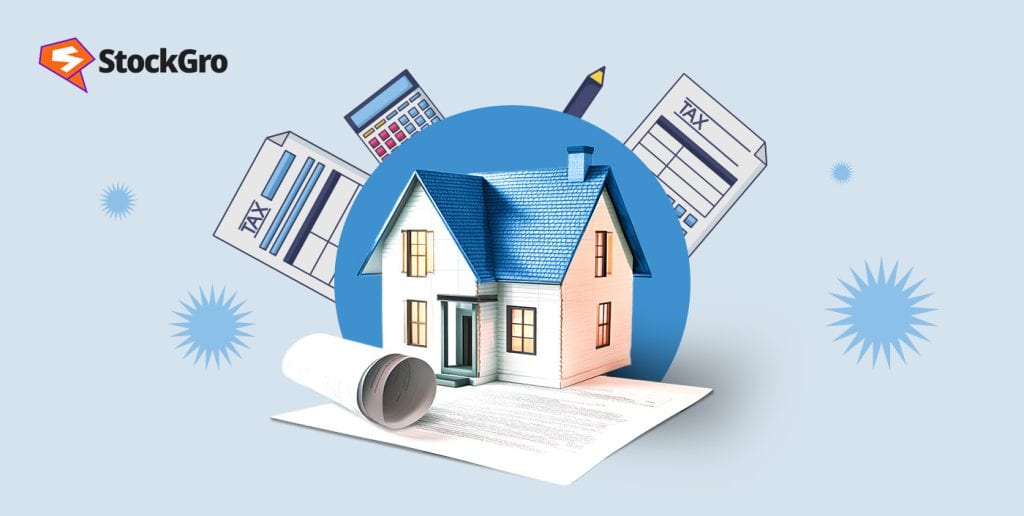
The housing prices are estimated to increase by 6.5% in 2025. The rise in pricing is due to the rise in demand for new homes. However, affordable housing and ‘Housing for All’ are some of the key initiatives of the Indian government to ensure equal economic growth for all Sections of society. Therefore, multiple tax deduction provisions are provided by the Government of India to deliver relief to home buyers.
Some major home loan tax benefits are provided to taxpayers in the form of provisions under Section 80EEA, 80EE and Section 24. This blog explores the home loan tax benefits offered specifically under 80 EEA and 24(b).
What is 80EEA?
Section 80EEA was introduced in the Union Budget 2019. It allows new homeowners to deduct up to ₹1.5 lakhs for housing loan interest payments. It is applicable to loans approved between 1 April 2019 and 31 March 2022. The deduction is applicable if the stamp duty value of the real estate doesn’t exceed ₹45 lakh. The taxpayers must meet certain other conditions to claim 80 EEA deductions.
What is Section 24(b)?
Homeowners can claim a tax deduction of up to ₹2,00,000 on interest paid towards a home loan for the construction or acquisition of a property under Section 24(b) of the Income Tax Act. Moreover, in case of reconstruction, repair or renewals, a deduction of up to ₹30,000 is allowed. Both privately owned homes and rental properties are eligible for this deduction. However, the loan must be used for the purchase, construction, or renovation of a property on or after April 1, 1999.
The table below shows the maximum deduction allowed for different house properties under Section 24(b).
| Purpose of loan | Maximum deduction under 24 (b) |
| Construction or acquisition | ₹2,00,000 |
| Repairs, reconstruction, renewals | ₹30,000 |
| Acquisition, construction, repair, reconstruction of let-out property | Original interest accrued on capital borrowed |
Conditions for claiming 80EEA deduction
The homebuyers must meet certain criteria to claim the exemption for housing loan interest provided by Section 80 EEA of the Income Tax Act. This Section explores these prerequisites in detail.
- Nature of taxpayer: 80EEA deductions apply only to individuals. Other kinds of assessee, like Hindu Undivided Family (HUF), Body of Individuals (BOI), companies, etc., cannot avail this deduction.
- Loan provider: The home loan must be taken from financial institutions alone. Deductions are not available for loans from unorganised lenders. Moreover, the credit taken must be a home loan utilised for purchasing real estate. As of the loan sanction date, the assessee cannot possess any other residential property.
- Loan tenure: The credit must be sanctioned by the financial institution within a fixed tenure. The eligible period begins from 1 April 2019 and ends on 31st March 2022. The exemption for housing loan interest cannot be availed if the loan is not taken within this tenure.
- Property value: The stamp duty value refers to the value of a property assessed by the state government or in certain cases, the central government. The stamp duty of a residential property must not exceed ₹45 lakhs to avail the 80 EEA deductions.
- 80EE: Taxpayers who cannot claim deductions under Section 80EE are eligible to claim deductions under Section 80EEA. A taxpayer cannot claim 80EEA deductions if they have already sought deductions under Section 80EE.
- Home loan amount: The amount of the loan taken should be at least ₹35 lakhs. If it is less than that, taxpayers will be eligible for 80EE deduction and thus cannot claim 80EEA deductions.
Also read: Capital Gains Tax on Stocks: What Investors Need to Know
Conditions for claiming Section 24 (b) deduction
Home loan tax benefits can be claimed under Section 24(b), subject to certain conditions. These conditions are discussed below.
- Taxpayer and property: Any structure or land that is attached to the said property is considered part of the house property. Furthermore, the property should belong to the taxpayer. The taxpayer is also not allowed to use the property for their professional or business endeavours. The homeowner should also not own any other property as of the date the loan is sanctioned.
- Loan tenure: The deduction is allowed if capital is borrowed on or after 1 April 1999. A loan taken before this date would not be allowed deductions under Section 24(b).
- Completion tenure: The acquisition or construction of the property must be completed within 5 years from the date of loan sanction.
- Nature of transaction: Taxpayers can claim 24(b) deduction for both the construction of a new home and the purchase of an existing property. The loan can also be claimed for the renovation of existing homes. However, the maximum deduction limit differs.
- 80EE and 80EEA: Section 24(b) deductions can be claimed over and above the deductions allowed under Section 80EEA. However, no other provision can be used along with Section 80EE.
Objectives of Section 80EEA and Section 24(b) deductions
The Indian government established Section 80EEA as part of its “Housing for All” initiative. Moreover, the fundamental aim of Sections 80EEA and 24B is to make housing affordable. The primary objectives of these are discussed below.
- Reduction of tax burden through home loan tax rebates and deductions.
- Addressing socio-economic issues like the lack of affordable housing.
- Reducing the tax burden on homeowners and inducing the purchase of real estate.
- It also gives a boost to the real estate industry in India.
Understanding the 80EEA and Section 24(b) deduction calculations
Section 80EEA allows individuals to claim deductions on home loan interest paid up to ₹1,50,000. The deduction can be utilised in each assessment year till the home loan is repaid. In addition to the deductions under Section 24, investors may also seek deductions under Section 80EEA.
| Maximum deduction under 80EEA | ₹1,50,000 |
| Dedication calculated on | Home loan interest |
| How many times can this deduction be used? | Till the loan is repaid |
| Can deduction under Section 24 be used along with Section 80EEA? | Yes |
The illustration below can crystallise the understanding of how the deduction for home loan interest can be used to reduce the tax burden.
Mr. A bought a residential property worth ₹40 lakhs. He makes a down payment of ₹10 lakhs and takes the remaining ₹30 lakhs as a loan. If the interest rate on the loan is 7% p.a., the calculation of tax deduction might look like the following.
Interest paid in the first year = ₹30,00,000 x 7% = ₹2,10,000
Now, the investor can claim some deductions. They are discussed in the table below.
| Section 24 | It comprises Sections 24(a) and 24(b). While 24(a) is a standard deduction, 24(b) refers to a deduction applicable based on home loan interest. Investors can claim up to ₹2,00,000 deduction through Section 24(b). |
| Section 80EEA | Investors can claim up to ₹1,50,000 through 80EEA deduction. However, this Section cannot be utilised if the assessee is already claiming a deduction under Section 80EE. |
| 80 C | The principal component of a home loan is eligible for a deduction of up to ₹1,50,000. |
Therefore, Section 80EEA allows an additional deduction of ₹1,50,000 per annum, over and above the benefits provided by Section 24 and Section 80C.
Mr. A can claim the deduction as follows.
Deduction claimed from 24(b) = ₹2,00,000
Dedication claimed from Section 80 EEA = Total interest – deduction already claimed under 24(b) = ₹2,10,000 – ₹2,00,000 = ₹10,000.
Differentiating between 80EEA, 80EE and Section 24(b)
The illustration above shows how taxpayers can reduce the tax burden by using Section 24(b) along with Section 80EEA. However, there is another method of claiming a deduction for home loan interest. This method is discussed under Section 80EE. The table below expresses the differences between the three Sections.
| Parameter | Section 80EE | Section 80EEA | Section 24(b) |
| Maximum deduction | 1,50,000 | ₹1,50,000 | 2,00,000 |
| Stamp duty value | Should not exceed ₹50 lakhs | Should not exceed ₹45 lakhs | No maximum or minimum limit |
| Loan amount | The maximum limit is ₹35 lakhs | It should be at least 35 lakhs. | No restriction regarding loan amount. |
| Other deduction | No other provision can be used along with 80EE. | It can be used along with Section 25 but cannot be used with Section 80EE. | It can be used with Section 80EEA. |
| Loan sanction period | The loan has been sanctioned by a financial institution during the financial year 2016-17. | The deduction applies to loans approved between 1 April 2019 and 31 March 2022. | The loan must be used for the purchase, construction, or renovation of a property on or after April 1, 1999. |
Also read: Unlocking tax benefits: Your guide to Section 80GG deductions
Conclusion
Section 80EEA and 24(b) enable taxpayers to reduce their tax burden and motivate real estate purchases. 80EEA provides a deduction of up to ₹1,50,000, subject to certain eligibility criteria. Whereas, 24(b) allows deduction up to ₹2,00,000.
Understanding the nuances of Section 80EEA and 24(b) can enhance its usage and optimise tax planning. Lack of optimum tax planning can cause undue erosion of funds.
Also read: How to do tax planning for high-income earners?
FAQs
Yes, Section 80EEA and Section 24B can be utilised together. Section 24 comprises Sections 24(a) and 24(b). While 24(a) is a standard deduction, 24(b) refers to a deduction applicable based on interest paid for a home loan. Investors can claim up to ₹2,00,000 deduction through Section 24(b). Moreover, investors can claim up to ₹1,50,000 under Section 80EEA. Taxpayers can utilise Section 24(b) along with Section 80EEA.
Taxpayers must meet certain conditions to claim 80EEA deductions. For instance, 80EEA deductions apply only to individuals. Moreover, the home loan must be taken from financial institutions alone. The loan must be sanctioned between 1 April 2019 and 31st March 2022. Additionally, the stamp duty of a residential property must not exceed ₹45 lakhs to avail the 80 EEA deductions. If homebuyers do not meet these conditions, they are not eligible to claim deductions under this Section.
Section 24 comprises Sections 24(a) and 24(b). While 24(a) is a standard deduction, 24(b) refers to a deduction applicable based on interest paid for a home loan. Investors can claim up to ₹2,00,000 deduction through Section 24(b). Moreover, investors can claim up to ₹1,50,000 under Section 80EEA. Taxpayers can utilise Section 24(b) along with Section 80EEA.
An Income Tax Return (ITR) is a document used by Indian taxpayers to declare their total taxable income, claim deductions and exemptions, and report taxes paid for a certain fiscal year to the Income Tax Department. The information provided on the ITR form is used to calculate the taxpayer’s net tax due or refund for the year.
No, investors cannot claim deductions from both Section 80EE and Section 80EEA. Taxpayers who cannot claim deductions under Section 80EE are eligible to claim deductions under Section 80EEA. Moreover, the amount of the loan taken should be at least ₹35 lakhs. If it is less than that, taxpayers will be eligible for the 80EE deduction and thus cannot claim 80EEA deductions.

